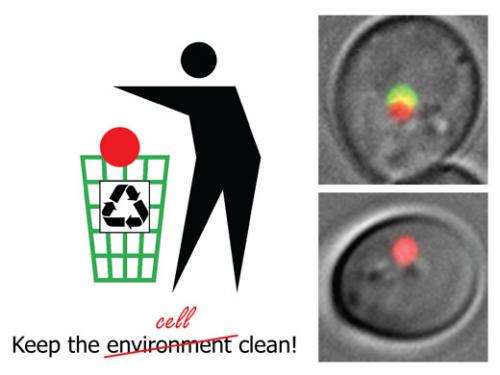Not just clean but spotless: Researchers show how cells tidy up

New findings from the team of Claudine Kraft at the Max F. Perutz Laboratories (MFPL) of the University of Vienna and the Medical University of Vienna give insights into how cells dispose of their waste. Malfunctions in this process have been linked to Alzheimer's disease and cancer. The study is published online in the renowned scientific journal Molecular Cell.
Autophagy – or how cells tidy up
"Bang and the dirt is gone!" There are many commercials for products that claim to make the unpopular process of cleaning up easier. But it's not only our surroundings that need to be kept clean. Even our cells need to tidy up. The responsible cellular process is called autophagy, in which the coordinated action of a set of proteins removes damaged cell material or pathogens, such as bacteria, from a cell. At the same time autophagy also helps cells to survive in times of starvation by recycling the cells' own components to produce energy, similar to recycling stations in a city.
The central player in autophagy: Atg1
For some time researcher had known the key coordinator of autophagy – the protein Atg1. However, how Atg1 exactly does its job remained unclear, despite the efforts of many groups worldwide. Now, the team of Claudine Kraft at the Max F. Perutz Laboratories (MFPL) of the University of Vienna showed that Atg1 modifies a set of proteins with a specific recognition sequence. In collaboration with their colleagues Gustav Ammerer at MFPL and Ben Turk at the University of Yale, they not only deciphered the recognition sequence but also determined the cellular proteins that actually contain this sequence. One, Atg9, caught the interest of the researchers in particular, as it is not only a known component of the cellular "waste bag", but also contains a stunning six of those specific recognition sequences. Daniel Papinski, first author of the study, explains: "Every cell contains specialized recycling stations. In order to dispose its waste, a cell needs to wrap it up, similar to putting garbage in a bag. This cellular trash bag can then be brought to the cellular recycling station where the waste is broken down into the re-usable parts." Atg9 is essential for this process.
How does Atg1 coordinate the packaging of cellular waste?
To test how Atg1 precisely regulates the packaging of cellular waste, the researchers altered the recognition sequences of Atg9. They found that in this case, Atg1 is unable to modify Atg9 and no autophagy, and therefore no cellular waste disposal, takes place. "This scenario is similar to that in cells that have no machinery to dispose of waste at all", says Claudine Kraft, lead author of the study. More experiments revealed that after modification by Atg1, Atg9 recruits other proteins – an interplay ensuring that cellular waste is packaged and disposed of. Involuntarily, the researcher saved the crucial and most exciting experiment for last. The method they used was only described a few months ago and allows monitoring how cells package their waste live under the microscope. Daniel Papinski says: "When we looked at cells that contained Atg9 with an altered recognition sequence, which Atg1 cannot modify, we observed that the wrapping up of the cellular waste stopped prematurely. Therefore, the proper function of Atg1 and Atg9 is crucial at the early stages of the waste disposal process, when the garbage is put into 'bags'."
A detailed understanding of such fundamental cellular events is essential for the study of diseases that go hand in hand with these processes – in the case of autophagy Alzheimer's disease and cancer – and in the long run will help to better treat or even prevent these diseases.
More information: Daniel Papinski, Martina Schuschnig, Wolfgang Reiter, Larissa Wilhelm, Christopher A. Barnes, Alessio Majolica, Isabella Hansmann, Thaddaeus Pfaffenwimmer, Monika Kijanska, Ingrid Stoffel, Sung Sik Lee, Andrea Brezovich, Jane Hua Lou, Benjamin E. Turk, Ruedi Aebersold, Gustav Ammerer, Matthias Peter, and Claudine Kraft: "Early steps in autophagy depend on direct phosphorylation of Atg9 by the Atg1 kinase." Molecular Cell (January 2014). dx.doi.org/10.1016/j.molcel.2013.12.011


















